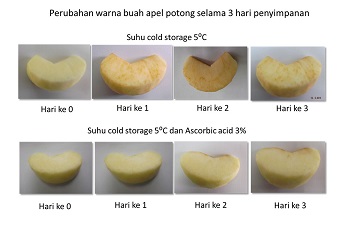A Group of IPB Researchers Analysed the Anti-browning Agent for Cut-fruits

There is a wonderful variety of delicious fruit to be found in Indonesia. Much of it is seasonal, while other fruits are available all year round. Throughout Indonesia, You’ll find unusual and succulent fruit, worthy of any palate. Enormous oranges ranging in colour from flame to dark green, mangoes of more than ten varieties, several kinds of more bananas, coconuts, pineapples, melons and mandarins, and not forgetting the pearly mangosteen, or the “smelly” Durian, said to be the only fruit that tigers eat. Some durian-lovers journey for miles to buy the fruit when it is out of miles others, repulsed by its odour, refuse to allow it to be brought near homes! Indonesia has a variety of apple grown here – the Malang apple. It is crunchier than any imported apple that you will eat, and you can utilized it as cut-fruit. Only, this fruit is very easy to change its colour shortly after cut, so it can degrade the quality.
Lecturer of the Department of Mechanical and Biosystem Engineering, of the Faculty of Agricultural Technology of Bogor Agricultural University (FATETA IPB), Y. Aris Purwanto, explained, when an apple is cut (or bruised), oxygen is introduced into the injured plant tissue. When oxygen is present in cells, polyphenol oxidase (PPO) enzymes in the chloroplasts rapidly oxidize phenolic compounds naturally present in the apple tissues to o-quinones, colourless precursors to brown-coloured secondary products. O-quinones then produce the well documented brown colour by reacting to form compounds with amino acids or proteins, or they self-assemble to make polymers. The browning occurs enzymatically, triggered by oxidation reactions catalyzed by phenol oxidase enzymes. This enzymatic browning reaction is undesirable, it lowers the quality and nutritive value of fresh-cut fruits.
Aris and his partner, Ririn Noerianty Effendi from the same Department, tried to find a solution to solve this problem. To reduce browning, the researchers tried to immerse the fruit on ascorbic acid and Aloe vera.
"Ascorbic acid is a common language vitamin C. Ascorbic acid and Aloe vera have the potential to be used to prevent browning reaction because it is edible coating. Aloe vera gel has been proven one of the best edible and biologically safe preservative coatings for different types of foods because of its film-forming properties, antimicrobial actions, biodegradability and biochemical properties. It is composed mainly of polysaccharides and acts as a natural barrier to moisture and oxygen, which are the main agents of deterioration of fruits and vegetables. Aloe vera gel has the ability to prolong shelf life of the fruits and vegetables by minimizing the rate of respiration and maintaining quality attributes (colour, flavor etc.). The immersion aims to reduce the reaction between polyphenolase enzymes, oxygen, and polyphenol compounds responsible for the browning reaction, so that the fruit will not become brown and its shelf life becomes more durable, "said Aris, who is also a researcher at the Research Center Tropical Horticulture (PKHT) of the Institute of Research and Community Empowerment of IPB (LPPM).
Aris stated, apples that had been cut were dipped into ascorbate solution and Aloe vera with various concentrations. Based on their experiments, this researcher explained that the effective anti browning solution used in preventing browning of apples Malang cut is ascorbic acid with 3 percent concentration.
"The immersion of cut-apples in ascorbic acid and Aloe vera anti-browning solution can prevent the initiation of browning by reacting with oxygen of cut-fruit apples of Malang, and the most effective was the 3 percent ascorbicate solution. Aloe vera gel coatings as an effective preservative to improve the safety, quality and functionality of fresh apple fruits, "he said. (Wied)



